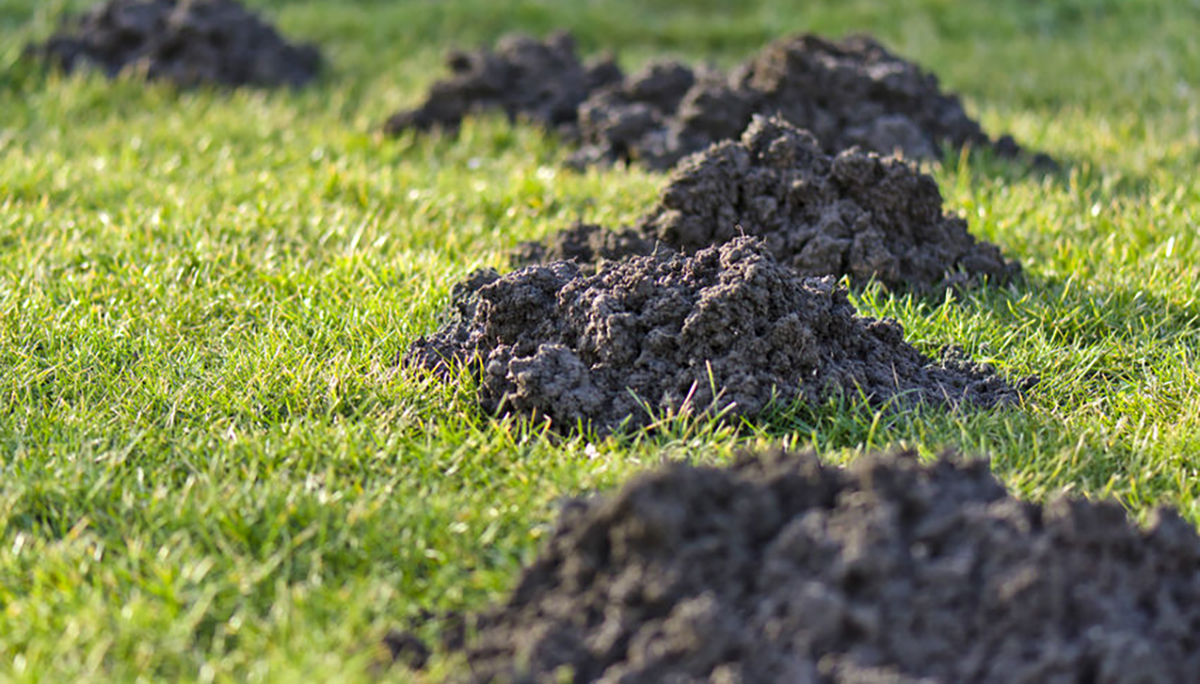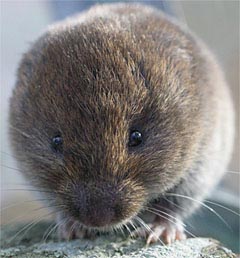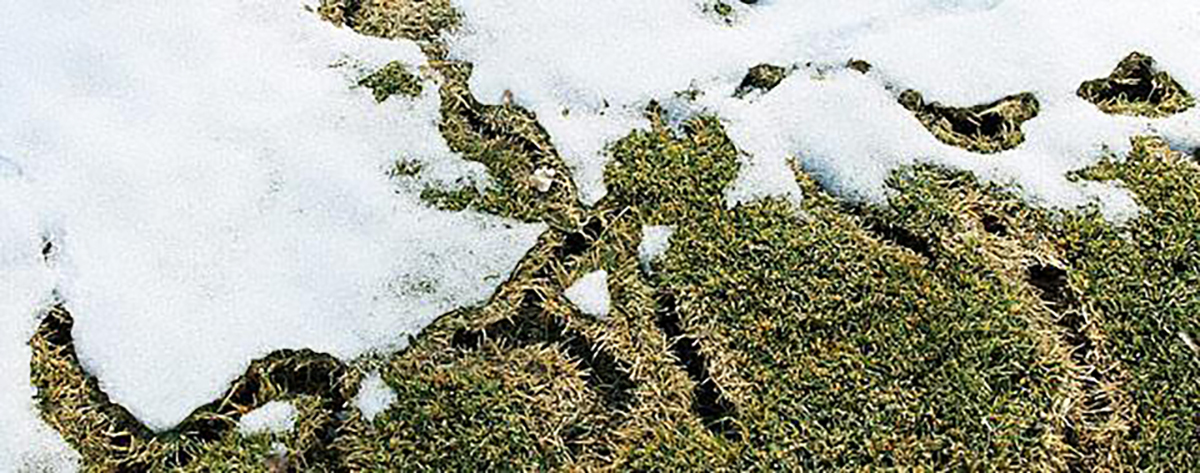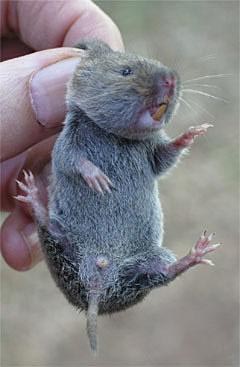How to Get Rid of Voles Without Killing Them
Tips for Repelling Moles & Voles
If you've ever witnessed your lawn or garden overtaken with moles, voles, or both, you know the devastation they can cause. Raised tunnels tearing apart your lawn and demolished plants can lead any gardener to despair. However, armed with the right tools, techniques, and knowledge of the "enemy" – and a healthy dose of determination – you can outwit those little critters and regain control.
"Moles have been ruining my yard and until I tried your Mole Repellent I was completely frustrated. Your site was great at helping me understand moles and your repellent was effective. Will buy again."
A Little Bit About Moles

Moles spend most of their lives underground, which means you'll see a lot more of the damage they leave behind than the animals themselves. From nose to tail, moles range in size from 4 to 8 inches. Moles have tiny eyes, they lack external ears, and their fur can vary from brown to black to gray. Although virtually blind, they can detect darkness and light, which is all they need for their subterranean lifestyle.
Having evolved into highly efficient diggers, they have large paddle-like front feet with prominent claws for digging. Their elongated heads and short necks give their body a streamlined shape to more easily push through the soil in search of food. As insectivores (insect-eaters), they eat grubs, snails, insects, and earthworms, which compose the majority of their diet.
Solitary animals, moles only come together to breed once a year in late winter to early spring. Gestation ranges from 2 to 4 weeks, and they usually give birth to a litter of 4 to 6 young. The young leave their nests about 4 weeks after birth.
Moles make their dens under trees, buildings, and sidewalks. They consist of many chambers connected with deeply dug runways, which protect them against predators such as foxes, coyotes, dogs, snakes, skunks, badgers, weasels, hawks, and owls. The shallower tunnels near the surface are hunting grounds for moles, and often they are used only once.
What Good Are Moles?
It may be hard to envision anything good about moles, especially if you've twisted your ankle in a mole tunnel. However, moles do provide a valuable service when it comes to soil management. Their tunneling loosens soil and provides aeration. It also causes soils to shift, blending surface soil with deeper sub-soil and improving overall soil quality. Additionally, moles consume numerous invertebrate pests. They are hearty eaters, consuming up to 100% of their body weight daily. So, while you may need to move moles out of your lawn, take consolation that they may have eaten a good share of Japanese beetle grubs.
Recognizing Mole Activity in your Garden

The two most common signs of mole activity are raised ridges in your lawn and the traditional molehill. These ridges come from tunneling just below the surface, and the cone-shaped molehill forms from the dirt a mole excavates as he digs the deeper tunnels around his den and living chambers.
Problems Caused by Moles
Moles can be a big problem for homeowners. Their tunneling creates unsightly ridges and may uproot plants, damaging or killing them. In addition, they can damage your turf's root system, as raised areas of grass dry out and die. Moles actively feed day and night, all year long. With the ability to tunnel up to 100 feet in a single day (about 15 feet per hour), it's essential to take action to control moles as soon as you discover them.
A Little Bit About Voles

Also known as "meadow mice," "field mice," and "pine mice," voles are rodents belonging to the same family as rats and mice. They measure between 3 to 5 inches in length, with stouter bodies and shorter tails than mice. Meadow voles live above ground, while pine voles live underground. They may be active both day and night and spend most of their time in tunnel systems below the ground. Voles eat grasses, roots, tubers, seeds, fruits, bark, and underground fungi.
Prolific breeders, voles can produce 4 to 6 litters a year. Their gestation period is about 3 weeks, and litter sizes can vary from 2 to 5. They reach maturity in about 40 days and can live up to 2 years.
Generally, voles prefer grassy areas and underbrush where their runways and grass tunnels are hard to spot by predators such as hawks, owls, foxes, snakes, and cats. Also, they readily use tunnels created by moles, and the two species often coexist in an area.
What Good Are Voles?

In addition to acting as a food source for larger animals, voles may benefit your lawn and garden. Like moles, their digging improves soil quality and disperses nutrients. They also encourage the growth of beneficial mycorrhizal fungi, symbiotic species that perform a critical function in the root systems of trees.
Recognizing Vole Activity in Your Garden
Signs of voles in your garden include 1- to 2-inch-wide runways on the surface of your yard. You can spot a vole's burrow by holes in your lawn or around the base of trees. The grass immediately surrounding the hole will be very short, and, unlike a molehill, there will be no soil mounding around the opening.
Problems Caused by Voles
Vole damage can occur at any time of year. In winter, when food is scarce, voles will gnaw the bark of shrubs and along the root collar of small trees, which can cause severe damage, even killing young trees. Voles will leave plants they have eaten with a pointed tip at the end of the stem. When voles eat roots and tubers underground, you'll be faced with a dead plant that, when lifted, has no visible root structure left.
How to Control Moles and Voles
Whether you have a problem with moles, voles, or both, the techniques to remove them are often the same. Get rid of one, and you'll take care of the other as well.
Many methods, humane and otherwise, exist for ridding moles and voles from your garden or lawn. Unfortunately, there is a lot of misinformation on this subject. Some techniques just don't work, while others can be dangerous. Also, certain species of moles and voles are endangered and protected, making it illegal to harm them. In order to solve your mole or vole problem, it's important to educate yourself and separate fact from fantasy.

Good Gardening Practice
Voles like living in mulch, leaf or grass piles, and tall ground covers. So, you can create a less-welcoming habitat if you don't mulch close to trees and keep mulch around shrubs to a minimum. Also, don't leave un-turned piles of leaves or lawn clippings around the yard.
Many homeowners think that stomping on the ridges made by moles will get rid of them. This technique, followed by a thorough watering, can help restore the root systems of turf, but don't think tamping alone can solve your pest problem. Moles dig their dens well below the surface, and they quickly dig new feeding tunnels for themselves.
Barrier Methods
You can't exactly stop a digging animal by putting up a fence. So, if you want to create a barrier around your lawn or garden, you need first to dig a trench at least 30 inches deep, then line it with hardware cloth or a similar mesh or netting that has holes no larger than ¾ inch. It will also need to extend 5 to 6 inches above the ground. Of course, you may only find this method practical for smaller spaces.
Hardware cloth can protect tree trunks from moles nibbling their bark. Just wrap the trunk up to 18 to 20 inches high. You can also protect bulbs by surrounding them with a mesh cage before planting, but you might find this impractical if working with many bulbs at once.
Household Chemicals
Some suggest pouring ammonia or bleach down mole or vole holes or soaking a cloth in the chemical and shoving it into the holes. Mothballs or moth flakes are also touted as a supposed repellent.
However, not only is there no evidence of such tactics being effective, but these highly toxic chemicals can impact more than just the targeted pest to harm other animals, plants, and even your soil itself.
Commercial Poisons
Commercially available mole and vole poisons primarily rely upon one of two rodenticides: bromethalin and zinc phosphide. The use of either poses a serious risk. To make these poisons more attractive to moles and voles, manufacturers often incorporate a lot of sugar into their products, which may attract children or pets. The danger of these poisons is so severe that some states prohibit their sale outright.
Zinc phosphide produces toxic phosphine gas when it interacts with the water and acid in a creature's stomach. Phosphine gas kills living cells within the body, destroying tissues. It targets the heart, lungs, and liver. After the mole or vole dies, its body presents a high risk of secondary poisoning, also known as "relay toxicity." Any animal who eats the mole will be poisoned itself, and a human simply handling the body can be poisoned by inhaling the phosphine gas.
Bromethalin attacks the nervous system, inhibiting the brain's ability to process oxygen. Without oxygen, the brain swells, causing death. Like zinc phosphide, bromethalin creates a risk of secondary poisoning. Many dogs and cats each year become sick after eating an animal killed by bromethalin. Even if it does not kill them, the nerve damage can cause seizures and an inability to move their hind legs.
Regardless of their killing power, many of these poisons may just not be effective because moles and voles don't see them as food. Even when formed like the earthworms that are moles favored prey, moles sometimes reject them because the smell or taste simply does not match the real thing, leaving uneaten poison in your yard or garden as a danger to other animals.
Grub Control
If you have a beetle problem, you may already be looking at treating your garden for grubs, and you may have heard that killing grubs will get rid of moles by robbing them of their food source. However, since moles consume many more earthworms than grubs, killing them may have little impact on mole populations.
Ultrasonic and Vibration Devices
These devices produce intermittent pulses that their manufacturers claim will annoy moles and voles. Regardless of the number of these available on the market, no field research supports their claims of effectiveness. In laboratory conditions, ultrasonic frequencies did make rodents reluctant to enter a space at first – but not when offered food. If moles or voles already know you have delicious treats in your garden, you should not trust ultrasonic repellents to send them away or keep them away.
Pray for Rain
April showers do more than bring May flowers. They keep rodent populations in check. Many animals – both adults and their young – who nest along or in the ground are susceptible to drowning in heavy rains.
Used Kitty Litter
Some suggest that used kitty litter will repel moles and voles when sprinkled every three feet. However, whether it actually works is questionable, and finding the right places to treat could be daunting. Also, you may decide it isn't worth handling used kitty litter for doubtful results. Used kitty litter can carry both the Toxoplasmosis parasite and E. coli bacteria, and you absolutely should not apply it to a vegetable garden.
Good Gardening Practice
Voles do not live long in areas without habitat. Voles like living in mulch, leaf and grass piles and tall ground covers. To keep voles out of the garden, do not mulch close to trees, and do not leave un-turned piles of leaves and lawn clippings around the yard. Keep mulch around shrubs to a minimum.
Chewing Gum
There are numerous stories that a piece of chewing gum placed in a mole hole will entice a mole. The mole is said to ingest the gum, choke on it, and die. Unfortunately, this method has been tested multiple times and proven to be nothing more than a myth.
"I want to thank you for I Must Garden Mole & Vole repellent! It works and your instructions were fantastic, I had no idea it was so important. My voles have not reappeared this year."
I Must Garden All-Natural Mole and Vole Repellent
Compared to all the methods listed above, we believe none can match I Must Garden Mole & Vole Repellent in its effectiveness or lack of harmful impact. All I Must Garden products are people, pet, and plant safe, and our Mole & Vole Repellent contains a super-strong concentration of 20% castor oil and other botanical oils.
Castor oil is a proven repellent to moles, voles, and other digging pests. ApplyingI Must Garden Mole & Vole Repellent to your yard will coat their favorite foods in castor oil. Suddenly, their food tastes awful. In addition to castor oil, our mole & vole repellent uses cedar oil, which repels insects that moles may eat, and peppermint oil, which irritates the nasal passages of rodents. The combination of these will cause moles and voles to leave the area quickly.
We recommend applying the repellent in sections over time, methodically moving the pests off your property toward an exit point. This allows the animals to relocate from a treated area to an adjacent untreated area. Since the animals have an option of moving to an untreated area, they simply relocate without causing further damage.
While this method is initially a little more time-consuming, it will be the most effective in gaining control over moles and voles. More detailed information on this application process is available here.
I Must Garden Mole & Vole Repellent comes in a granular form, which can be dispersed by a mechanical spreader or by hand, and as a liquid concentrate hose-end sprayer. The right one for you will depend on personal preference and the shape of the area you wish to treat.
We want you to be satisfied with every purchase from I Must Garden. If you have any questions or concerns, please contact us.
How to Get Rid of Voles Without Killing Them
Source: https://www.imustgarden.com/repel-moles-voles